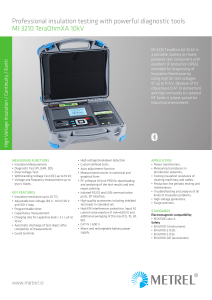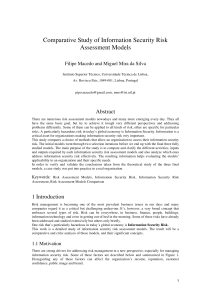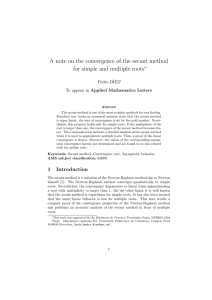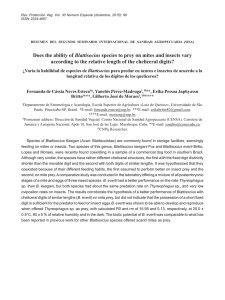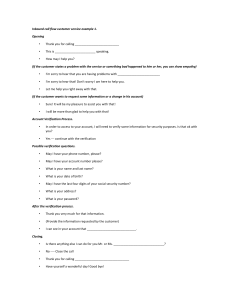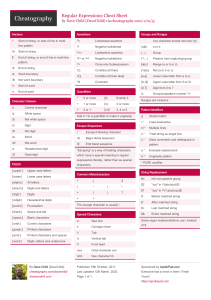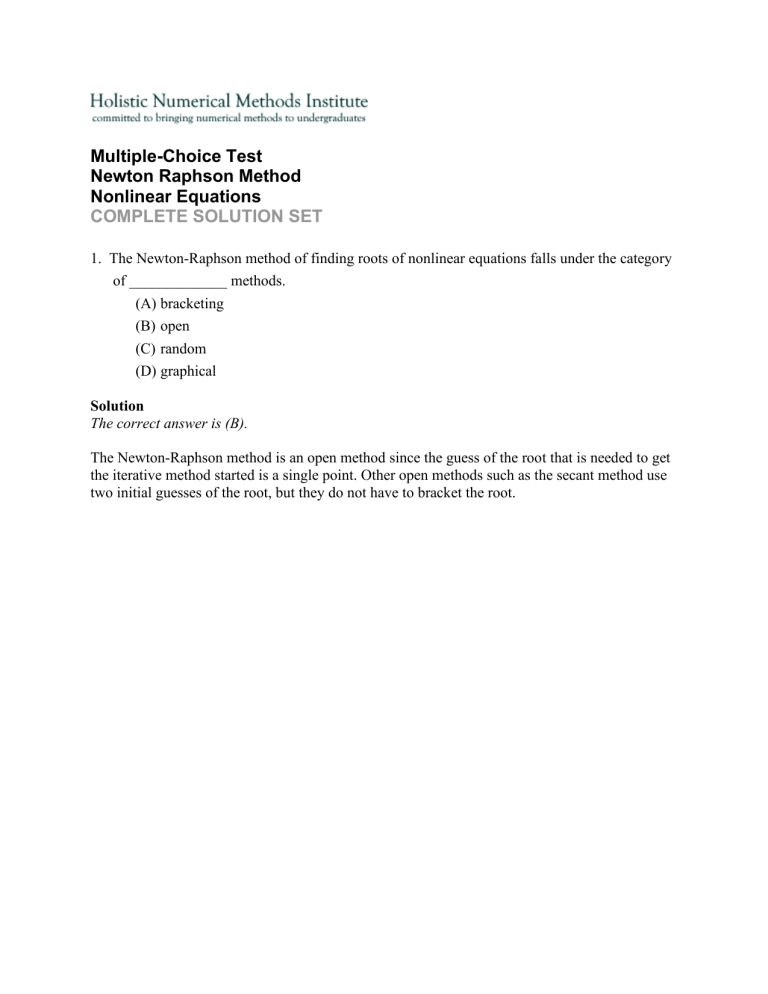
Multiple-Choice Test Newton Raphson Method Nonlinear Equations COMPLETE SOLUTION SET 1. The Newton-Raphson method of finding roots of nonlinear equations falls under the category of _____________ methods. (A) bracketing (B) open (C) random (D) graphical Solution The correct answer is (B). The Newton-Raphson method is an open method since the guess of the root that is needed to get the iterative method started is a single point. Other open methods such as the secant method use two initial guesses of the root, but they do not have to bracket the root. 2. The Newton-Raphson method formula for finding the square root of a real number R from the equation 𝑥𝑥 2 − 𝑅𝑅 = 0 is, 𝑥𝑥 (A) 𝑥𝑥𝑖𝑖+1 = 2𝑖𝑖 (B) 𝑥𝑥𝑖𝑖+1 = 3𝑥𝑥𝑖𝑖 2 1 𝑅𝑅 (C) 𝑥𝑥𝑖𝑖+1 = 2 �𝑥𝑥𝑖𝑖 + 𝑥𝑥 � 1 𝑖𝑖 𝑅𝑅 (D) 𝑥𝑥𝑖𝑖+1 = 2 �3𝑥𝑥𝑖𝑖 − 𝑥𝑥 � 𝑖𝑖 Solution The correct answer is (C). The Newton-Raphson method formula for solving f(x) = 0 is 𝑓𝑓(𝑥𝑥𝑖𝑖 ) 𝑥𝑥𝑖𝑖+1 = 𝑥𝑥𝑖𝑖 − ′ 𝑓𝑓 (𝑥𝑥𝑖𝑖 ) where 𝑓𝑓(𝑥𝑥) = 𝑥𝑥 2 − 𝑅𝑅 𝑓𝑓 ′ (𝑥𝑥) = 2𝑥𝑥 Thus, 𝑥𝑥𝑖𝑖2 − 𝑅𝑅 𝑥𝑥𝑖𝑖+1 = 𝑥𝑥𝑖𝑖 − 2𝑥𝑥𝑖𝑖 𝑥𝑥𝑖𝑖2 − 𝑅𝑅 = 𝑥𝑥𝑖𝑖 − � � 2𝑥𝑥𝑖𝑖 𝑥𝑥𝑖𝑖 𝑅𝑅 � = 𝑥𝑥𝑖𝑖 − � − 2 2𝑥𝑥𝑖𝑖 𝑥𝑥𝑖𝑖 𝑅𝑅 = 𝑥𝑥𝑖𝑖 − + 2 2𝑥𝑥𝑖𝑖 1 𝑅𝑅 = 𝑥𝑥𝑖𝑖 + 2 2𝑥𝑥𝑖𝑖 1 𝑅𝑅 = �𝑥𝑥𝑖𝑖 + � 2 𝑥𝑥𝑖𝑖 3. The next iterative value of the root of 𝑥𝑥 2 − 4 = 0 using the Newton-Raphson method, if the initial guess is 3, is (A) 1.5 (B) 2.067 (C) 2.167 (D) 3.000 Solution The correct answer is (C). The estimate of the root is 𝑓𝑓(𝑥𝑥𝑖𝑖 ) 𝑥𝑥𝑖𝑖+1 = 𝑥𝑥𝑖𝑖 − ′ 𝑓𝑓 (𝑥𝑥𝑖𝑖 ) Chose i = 0, 𝑥𝑥0 = 3 𝑓𝑓(𝑥𝑥0 ) = 𝑥𝑥0 2 − 4 = 32 − 4 =5 ′ 𝑓𝑓 (𝑥𝑥0 ) = 2𝑥𝑥0 = 2×3 =6 Thus, 𝑓𝑓(𝑥𝑥0 ) 𝑥𝑥1 = 𝑥𝑥0 − ′ 𝑓𝑓 (𝑥𝑥0 ) 5 =3− 6 = 2.166 4. The root of the equation 𝑓𝑓(𝑥𝑥) = 0 is found by using the Newton-Raphson method. The initial estimate of the root is 𝑥𝑥0 = 3, 𝑓𝑓(3) = 5. The angle the line tangent to the function 𝑓𝑓(𝑥𝑥) makes at 𝑥𝑥 = 3 is 57° with respect to the x-axis. The next estimate of the root, 𝑥𝑥1 most nearly is (A) –3.2470 (B) −0.24704 (C) 3.2470 (D) 6.2470 Solution The correct answer is (B). f(x) f(x0) [x0,f(x0)] f(x1) θ x1 x0 Δx Since, 𝜃𝜃 = 57°, 𝑥𝑥0 = 3, and 𝑓𝑓(𝑥𝑥0 ) = 5 𝑟𝑟𝑟𝑟𝑟𝑟𝑟𝑟 𝑡𝑡𝑡𝑡𝑡𝑡( 𝜃𝜃) = 𝑟𝑟𝑟𝑟𝑟𝑟 𝑓𝑓(𝑥𝑥0 ) − 𝑓𝑓(𝑥𝑥1 ) 𝑡𝑡𝑡𝑡𝑡𝑡( 57°) = 𝑥𝑥0 − 𝑥𝑥1 5−0 𝑡𝑡𝑡𝑡𝑡𝑡( 57°) = 3 − 𝑥𝑥1 5 − 3(𝑡𝑡𝑡𝑡𝑡𝑡( 57°)) 𝑥𝑥1 = − 𝑡𝑡𝑡𝑡𝑡𝑡( 57°) 5 − 3 × 1.5399 = −1.5399 x = −0.24704 5. The root of 𝑥𝑥 3 = 4 is found by using the Newton-Raphson method. The successive iterative values of the root are given in the table below. Iteration Number Value of Root 0 2.0000 1 1.6667 2 1.5911 3 1.5874 4 1.5874 The iteration number at which I would first trust at least two significant digits in the answer is (A) 1 (B) 2 (C) 3 (D) 4 Solution The correct answer is (C). The absolute relative approximate error for the first iteration is 1.6667 − 2 |∈𝑎𝑎 | = � � × 100 1.6667 = |−0.19999| × 100 = 19.999% Since, 19.99% ≤ 0.5 × 102−𝑚𝑚 , 𝑚𝑚 = 0. There are no significant digits correct. The absolute relative approximate error for the second iteration is 1.5911 − 1.6667 |∈𝑎𝑎 | = � � × 100 1.5911 = |−0.047514| × 100 = 4.7514% Since, 4.7514% ≤ 0.5 × 102−𝑚𝑚 , 𝑚𝑚 = 1. There is at least one significant digit correct. The absolute relative approximate error for the third iteration is 1.5874 − 1.5911 |∈𝑎𝑎 | = � � × 100 1.5874 = |−0.0023308| × 100 = 0.23308% Since, 0.23308% ≤ 0.5 × 102−𝑚𝑚 ,𝑚𝑚 = 2. There are at least two significant digits correct. Thus, the third iteration is the first iteration in which at least two significant digits are correct. 6. The ideal gas law is given by 𝑝𝑝𝑝𝑝 = 𝑅𝑅𝑅𝑅 where 𝑝𝑝 is the pressure, 𝑣𝑣 is the specific volume, 𝑅𝑅 is the universal gas constant, and 𝑇𝑇 is the absolute temperature. This equation is only accurate for a limited range of pressure and temperature. Vander Waals came up with an equation that was accurate for larger range of pressure and temperature given by 𝑎𝑎 �𝑝𝑝 + 𝑣𝑣2 � (𝑣𝑣 − 𝑏𝑏) = 𝑅𝑅𝑅𝑅 where a and b are empirical constants dependent on a particular gas. Given the value of 𝑅𝑅 = 0.08, 𝑎𝑎 = 3.592, 𝑏𝑏 = 0.04267, 𝑝𝑝 = 10 and 𝑇𝑇 = 300 (assume all units are consistent), one is going to find the specific volume, 𝑣𝑣, for the above values. Without finding the solution from the Vander Waals equation, what would be a good initial guess for 𝑣𝑣? (A) 0 (B) 1.2 (C) 2.4 (D) 3.6 Solution The correct answer is (C). From the physics of the problem, the initial guess can be found from the linear relationship of the ideal gas law 𝑝𝑝𝑝𝑝 = 𝑅𝑅𝑅𝑅 𝑅𝑅𝑅𝑅 𝑣𝑣 = 𝑝𝑝 0.08 × 300 = 10 = 2.4
